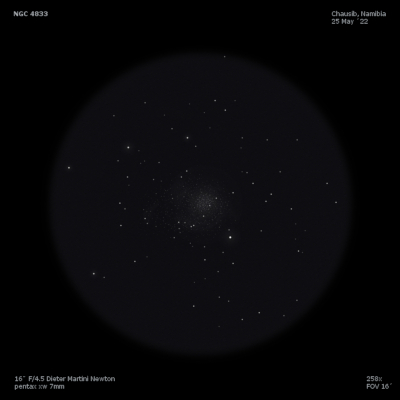
10x30mm Canon IS (3/27/19 - Tasmania): moderately bright and large globular, round. Contains a brighter star on the north edge.
Nicolas-Louis de Lacaille discovered NGC 4833 = Lac I-4 = D 164 = h3444 in 1751-1752 with a 1/2-inch telescope at 8x during his expedition to the Cape of Good Hope. He included it in his 1755 catalogue as I-4, classifying it as a nebula, and noting it resembled "a small faint comet."
James Dunlop observed this globular with his 9-inch f/12 speculum reflector on 29 Apr 1826 (second night he recorded objects) from Parramatta, New South Wales and described "a pretty bright round nebula, about 4' diameter, moderately condensed to the centre. This, with the sweeping power, has the appearance of a globe of numerous matter with very small stars in the north following margin. But with a power sufficient to resolve it, the globular appearance vanishes in a very considerable degree; and the brightest and most condensed part is to the preceding side of the centre, with the stars considerably scattered on the N.f. side. Resolvable into stars of mixt small magnitudes. A small nebula precedes this." He observed the cluster on 5 nights.
John Herschel first recorded "globular cluster, B, L, R, gbM, stars 14th mag, and one 7th mag north-preceding the centre; a fine object." On a second sweep he logged "globular cluster, pB, L, p rich, at first gradually, then vspmbM; diameter of the bright part 3', of the loose stars 10'; stars 12..16th mag, and one large one 7th mag, 3' or 4' north of the centre."
400/500mm - 18" (7/10/02 - Magellan Observatory, Australia): This was a surprising find for a little known globular! At 171x, it appeared as a bright, fairly large globular of low concentration class. The loose halo was highly resolved and numerous stars were splashed across the brighter core. Many of the stars formed large loops and chains. A single bright star (mag 8.7 SAO 256996) is superimposed on the northern side of the halo. The core spans roughly 3', while outliers increase the overall halo to at least 10' [John Herschel gave similar dimensions]. Located 42' NNW of mag 3.6 Delta Muscae and 3° NE of gc NGC 4372 which is a comparable cluster.
600/800mm - 24" (4/12/08 - Magellan Observatory, Australia): at 260x this is a gorgeous highly resolved globular with several hundred stars splashed across the core and within a loose, well-resolved halo. The center is strongly compressed with a very bright 3' core surrounded by a large halo, roughly 10' in diameter. Beyond 5' or 6' out from the center the halo becomes scraggly but continues to extend out in loops and strings. A brighter mag 8.7 star is superimposed in the halo, 2.5' N of center.
Notes by Steve Gottlieb